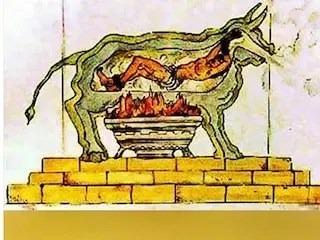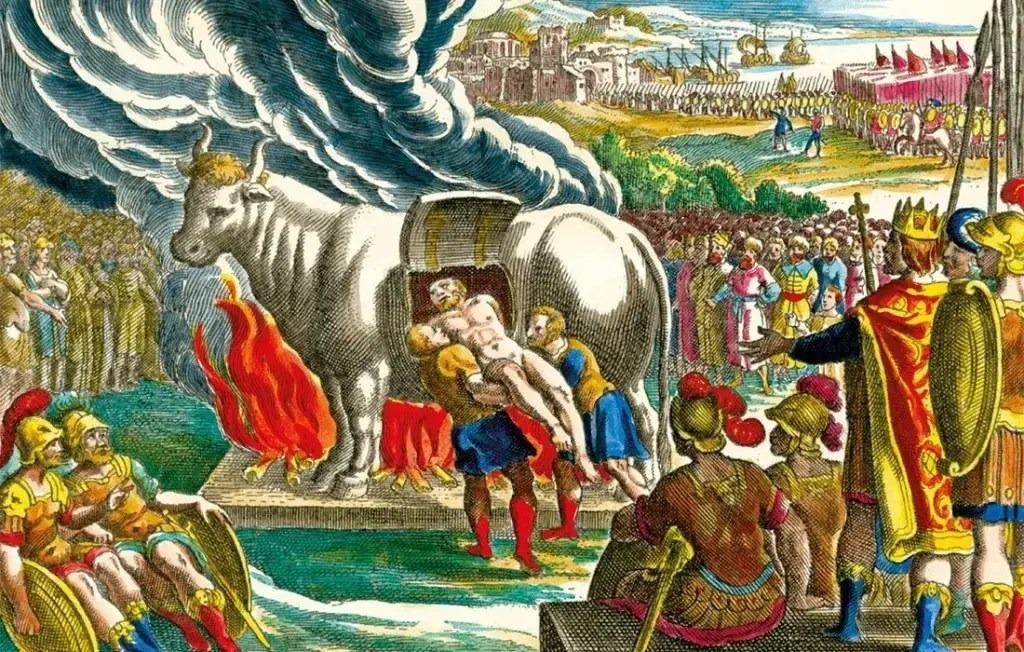History is filled with inventions that transformed societies for the better—tools, machines, and technologies that advanced human progress. But there are also inventions that reflect the darker side of creativity. Among the most infamous is the Brazen Bull, a legendary device said to have been conceived in ancient Greece. Known for its chilling design and macabre story, the Brazen Bull stands as a symbol of cruelty, myth, and the dangers of unchecked ambition.
The most striking part of its tale? According to ancient accounts, the device’s creator was allegedly its very first victim.
The Origins of the Brazen Bull

The Brazen Bull is most often associated with the Greek city of Akragas (modern Agrigento, Sicily) during the reign of the tyrant Phalaris, who ruled in the 6th century BCE. Historical texts describe Phalaris as a ruler both powerful and ruthless, a man remembered as much for his cruelty as for his leadership.
The story goes that a craftsman named Perillos of Athens presented Phalaris with a new invention—a hollow bronze statue of a bull, designed not as art but as a device of punishment. It was engineered with remarkable detail, its hollow body capable of containing a human being. Pipes and vents were placed in such a way that sounds from inside would echo and transform, supposedly resembling the bellow of an enraged bull.
Whether entirely true or partly exaggerated by later writers, the story of the Brazen Bull became a lasting example of how human ingenuity can be turned toward sinister ends.
A Device of Symbolism and Fear
The Brazen Bull was more than a simple tool of punishment. Its design carried deep symbolism:
-
The bull in Greek culture: Bulls were powerful symbols of strength, fertility, and divine authority, appearing frequently in Greek mythology and ritual. Transforming this animal into a weapon of terror inverted its meaning, turning a revered creature into a symbol of suffering.
-
A warning to enemies: Public punishment through such a device was not just about the victim but about intimidating all who witnessed it.
-
The blending of art and cruelty: Crafted from polished bronze, the device would have looked majestic at first glance, concealing its darker function.
In this way, the Brazen Bull illustrates how ancient rulers sometimes used spectacle to consolidate power—turning punishment into performance.
The Creator’s Fate: Fact or Folklore?

According to later accounts, including those by Diodorus Siculus and other ancient historians, the tyrant Phalaris was not impressed by Perillos’s cruelty. To test the invention, Phalaris allegedly ordered its own creator to demonstrate how it worked. Perillos was forced into the bull, making him its first victim.
The story serves as a moral parable: the designer of cruelty falling prey to his own invention. Whether historically accurate or not, it encapsulates the age-old warning against creating tools of harm.
Historical Debates and Skepticism
Modern historians debate whether the Brazen Bull ever truly existed or whether it was an exaggerated tale used to paint Phalaris as a tyrant. Ancient sources often blurred the line between history and myth, especially when describing rulers with reputations for cruelty.
Some scholars suggest the Brazen Bull may have been symbolic, a metaphor for tyranny rather than a literal device. Others believe it may have existed but that its accounts were sensationalized over time. The absence of archaeological evidence leaves the question open, making the Brazen Bull as much a legend as a historical artifact.
The Brazen Bull in Cultural Memory

Regardless of its authenticity, the Brazen Bull has endured in cultural imagination for centuries. Writers, artists, and filmmakers have returned to its story as a symbol of human cruelty and the misuse of ingenuity.
-
In literature: References to the Brazen Bull appear in works from antiquity through the Renaissance, often as moral lessons.
-
In modern culture: It has been depicted in movies, novels, and video games, usually as a grim emblem of ancient brutality.
-
As a metaphor: Beyond literal interpretations, the Brazen Bull symbolizes the destructive potential of innovation when guided by malice instead of morality.
Its continued presence in cultural memory demonstrates how legends, whether fully true or not, carry enduring power.
Lessons from the Legend
The tale of the Brazen Bull offers several insights:
-
The double edge of creativity: Human ingenuity can create wonders or horrors, depending on intent.
-
Power and fear: Rulers often used spectacle to project authority, blending punishment with performance.
-
The morality tale: By making Perillos the first victim, the story reminds us that cruelty often destroys even its creators.
In this way, the Brazen Bull remains relevant as a cautionary tale, warning us about the ethical responsibilities that accompany innovation.
Mystery, Folklore, and Imagination

What keeps the story alive today is not just its gruesome details but the way it sits at the crossroads of mystery, folklore, and imagination. Did such a device truly exist, or was it a tale meant to capture the dangers of tyranny? Was Phalaris truly so cruel, or was the story part of propaganda by his enemies?
These unanswered questions give the Brazen Bull its enduring allure. Like many ancient legends, it invites us to explore not only the facts of history but also the stories societies tell to make sense of power, cruelty, and justice.
Conclusion: A Symbol That Outlived Its Time
The Brazen Bull may never have existed as described in ancient texts, but its legend has endured for over two millennia. Whether fact, fabrication, or a mixture of both, it stands as one of history’s most haunting reminders of the human capacity for both creativity and cruelty.
Most importantly, the tale of the Brazen Bull reminds us that the inventions we create—whether weapons, tools, or technologies—carry moral weight. Just as Perillos’s alleged fate warns against devising instruments of suffering, our own age calls for reflection on how innovation can be guided by compassion rather than harm.
In the end, the Brazen Bull is more than a story about a bronze device. It is a parable about power, imagination, and the responsibility of creators. And that is why, thousands of years later, it continues to echo through history as a chilling lesson from the ancient world.
